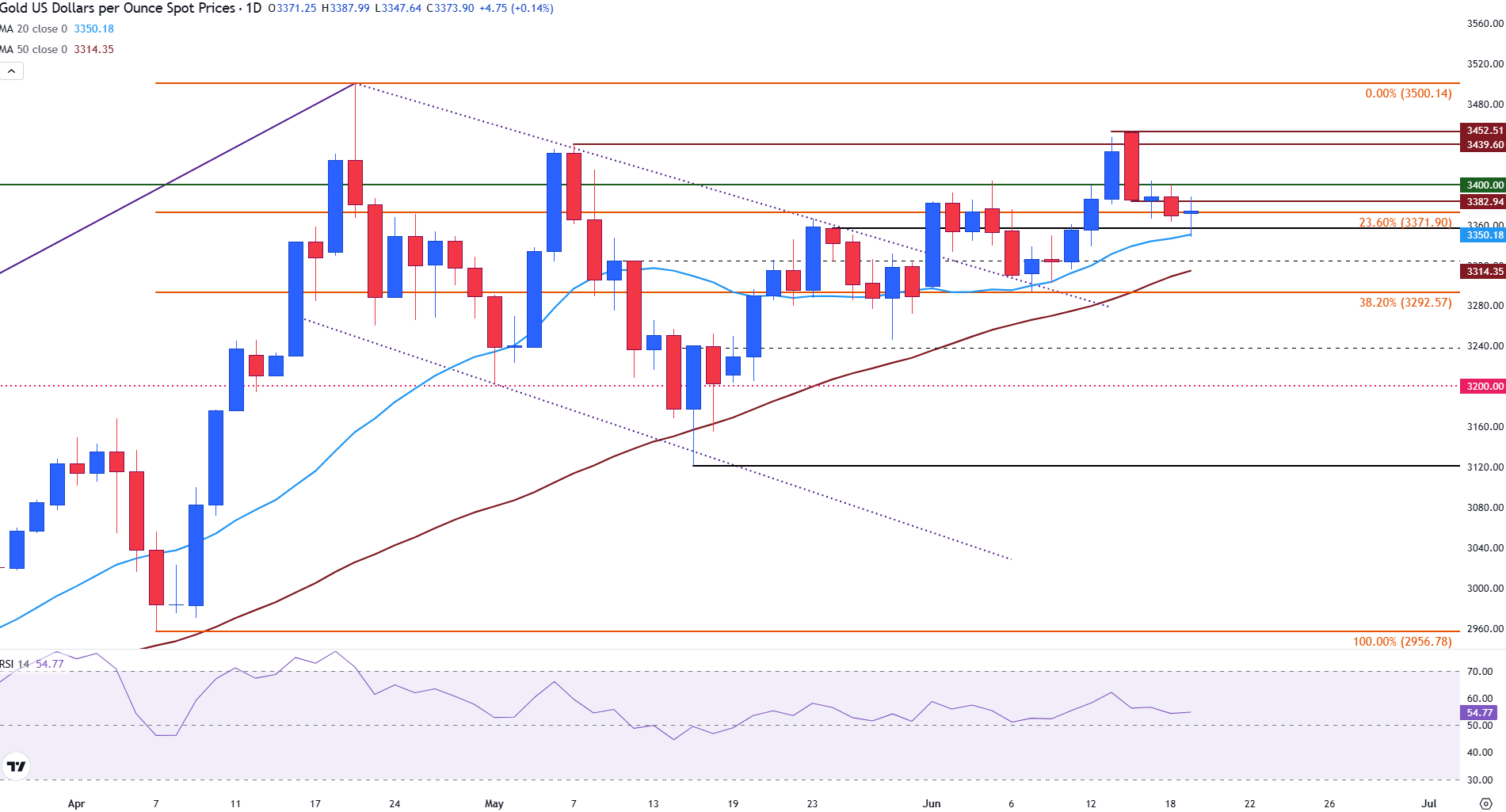- Gold remains firm while operators balance safe refuge flows and the Fed interest rates perspective.
- Tensions between the US and Iran, the Fed data dependent posture and the oil supply risks in the care center.
- The Xau/USD moves laterally below $ 3,400 in the middle of a low volume on a holiday in the US.
Gold (Xau/USD) is being negotiated within a well -defined range on Thursday, staying between $ 3,340 and $ 3,400. These levels have consistently acted as support and short -term resistance during the last week.
With the United States (USA) observing the holiday of Juneteenth, negotiation volumes remain light. However, key macro and geopolitical issues continue to mold the dynamics of the price of gold after the last Federal Reserve Policy (Fed) on Wednesday.
Fed’s rates decision and Powell’s comments drive the dollar
On Wednesday, the Fed maintained its reference interest rate without changes in the range of 4.25%–4.50%, as expected. However, while the updated projections of the Federal Open Market Committee (FOMC) indicated two rates cuts for the end of the year, the markets were surprised by the cautious tone of President Jerome Powell during his press conference.
Gold initially benefited from the perspective of moderate rates, with the Xau/USD, rising towards the level of $ 3,400, a key psychological barrier. However, Powell emphasized a data -dependent approach and reiterated concerns about inflation, which moderated the enthusiasm for a rate cut and, ultimately, it strengthened the US dollar (USD), limiting the intradic increase of the Xau/USD.
While the yields of the US Treasury bonds in the longest term fell in response to the perspective of feat cuts, short -term yields recovered as Powell adopted a firmer tone, reflecting the continuous caution of the Fed by declaring victory over inflation.
Israel-Iran conflict provides continuous support for gold
Beyond monetary policy, the ongoing conflict between Israel and Iran continues to act as an upward risk for gold. The growing speculation that the US could be involved directly in a military manner has increased market concerns.
Any interruption in global oil flows, particularly through the Ormuz Strait, could rekindle inflationary fears and increase the demand for bullion.
In this context, gold continues to serve as a coverage against geopolitical instability and possible economic repercussions of prolonged global tensions.
The president of the USA, Donald Trump, has a meeting with the US National Security team on Thursday for the second meeting this week to discuss whether the US will increase their participation in tensions in the Middle East.
What moves the market today: factors to observe for gold
- The growing enriched uranium stockpile of Iran has climbed the concerns about its potential to develop a nuclear weapon. Both Israel and the United States have publicly declared that such a result would be unacceptable.
- The conflict has intensified the fears of the Ormuz Strait, a maritime critical point located at the northern entrance of the Persian Gulf. Approximately 20% of global energy products travel through this narrow passage.
- Any interruption in maritime transport in the Strait could cause oil prices to rise abruptly, adding renewed inflationary pressure and complicating the trajectory of interest rates of the Federal Reserve.
- On Wednesday, President Trump requested a rate cut of 2.5% and referred to the president of the FED, Jerome Powell, as “stupid”, further criticizing his leadership before Powell’s mandate ends in May 2026. Although he did not immediately move the market, these comments increased the background uncertainty.
- President Powell reiterated that the US economy is still “solid”, but warned about the growing risks related to tariffs, reinforcing the Fed data dependent position in the future.
- A possible climbing in the Middle East could increase the demand for gold as coverage against inflation, but the greatest yields in the US, driven by persistent inflation, could limit profits or regret over the metal.
Technical Analysis: Gold Alcistas become cautious about $ 3,370
From a technical point of view, the fibonacci setback drawn from the minimum of April about $ 2,955 to April maximum in $ 3,500 stands out several key levels that operators are observing closely.
At the time of writing, prices are being negotiated around $ 3,365, with immediate resistance located in the fibonacci setback of 23.6% of the April movement, at $ 3,371. This level is located just above the simple mobile average (SMA) of 20 days at $ 3,350, reinforcing the short -term importance of this area.
For the Xau/USD to resume its upward trajectory, a break above $ 3,371 could open the door to the next level of psychological resistance by $ 3,400. Above that is the weekly maximum of $ 3,452, which could take prices to the April 3,500 record.
At the bottom, a 20 -day SMA rupture could lead to the 50 -day SMA in view of $ 3.314 and to another psychological support zone at $ 3,300.
At the same time, the impulse of the upward trend is showing signs of deceleration with the relative force index (RSI) resting in 54, pointing out a more neutral tone compared to the 60th -view reading last week.
Daily Gold Graph:

US dollar FAQS
The US dollar (USD) is the official currency of the United States of America, and the “de facto” currency of a significant number of other countries where it is in circulation along with local tickets. According to data from 2022, it is the most negotiated currency in the world, with more than 88% of all global currency change operations, which is equivalent to an average of 6.6 billion dollars in daily transactions. After World War II, the USD took over the pound sterling as a world reserve currency.
The most important individual factor that influences the value of the US dollar is monetary policy, which is determined by the Federal Reserve (FED). The Fed has two mandates: to achieve price stability (control inflation) and promote full employment. Its main tool to achieve these two objectives is to adjust interest rates. When prices rise too quickly and inflation exceeds the 2% objective set by the Fed, it rises the types, which favors the price of the dollar. When inflation falls below 2% or the unemployment rate is too high, the Fed can lower interest rates, which weighs on the dollar.
In extreme situations, the Federal Reserve can also print more dollars and promulgate quantitative flexibility (QE). The QE is the process by which the Fed substantially increases the flow of credit in a stuck financial system. It is an unconventional policy measure that is used when the credit has been exhausted because banks do not lend each other (for fear of the default of the counterparts). It is the last resort when it is unlikely that a simple decrease in interest rates will achieve the necessary result. It was the weapon chosen by the Fed to combat the contraction of the credit that occurred during the great financial crisis of 2008. It is that the Fed prints more dollars and uses them to buy bonds of the US government, mainly of financial institutions. Which usually leads to a weakening of the US dollar.
The quantitative hardening (QT) is the reverse process for which the Federal Reserve stops buying bonds from financial institutions and does not reinvote the capital of the wallet values that overcome in new purchases. It is usually positive for the US dollar.
Source: Fx Street
I am Joshua Winder, a senior-level journalist and editor at World Stock Market. I specialize in covering news related to the stock market and economic trends. With more than 8 years of experience in this field, I have become an expert in financial reporting.







